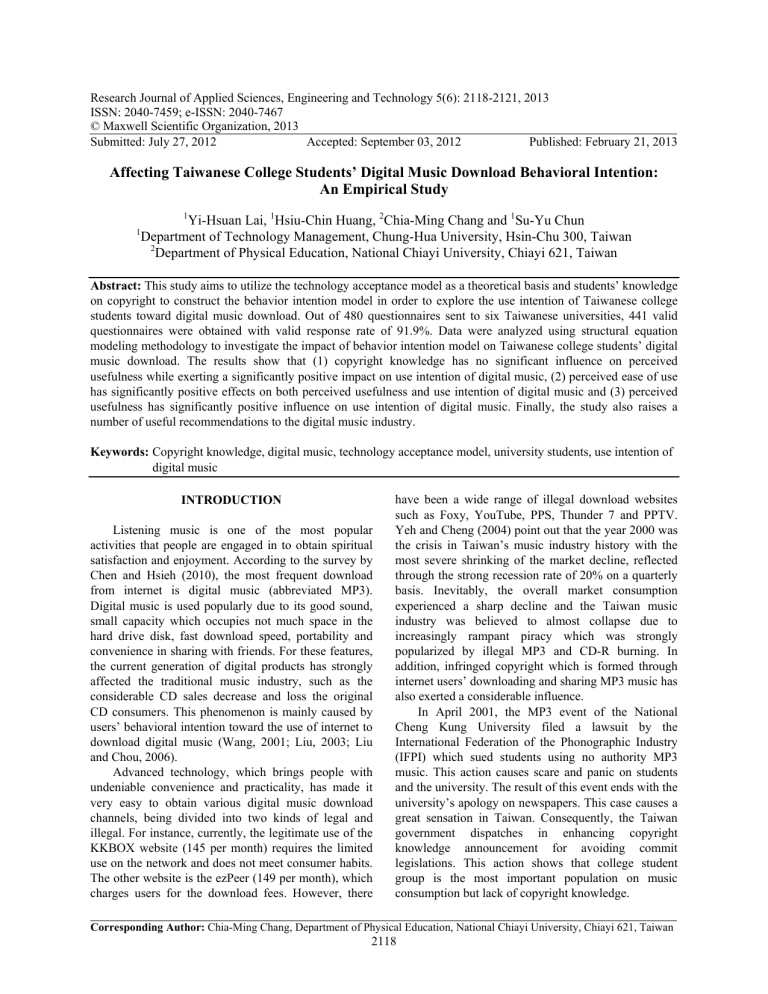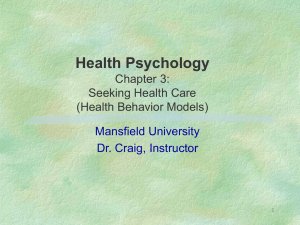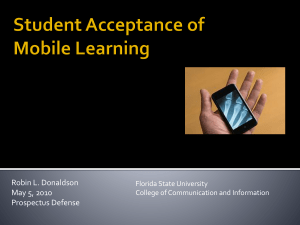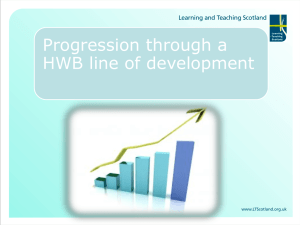Research Journal of Applied Sciences, Engineering and Technology 5(6): 2118-2121,... ISSN: 2040-7459; e-ISSN: 2040-7467

Research Journal of Applied Sciences, Engineering and Technology 5(6): 2118-2121, 2013
ISSN: 2040-7459; e-ISSN: 2040-7467
© Maxwell Scientific Organization, 2013
Submitted: July 27, 2012 Accepted: September 03, 2012 Published: February 21, 2013
Affecting Taiwanese College Students’ Digital Music Download Behavioral Intention:
An Empirical Study
1
Yi-Hsuan Lai,
1
Hsiu-Chin Huang,
2
Chia-Ming Chang and
1
Su-Yu Chun
1
Department of Technology Management, Chung-Hua University, Hsin-Chu 300, Taiwan
2
Department of Physical Education, National Chiayi University, Chiayi 621, Taiwan
Abstract: This study aims to utilize the technology acceptance model as a theoretical basis and students’ knowledge on copyright to construct the behavior intention model in order to explore the use intention of Taiwanese college students toward digital music download. Out of 480 questionnaires sent to six Taiwanese universities, 441 valid questionnaires were obtained with valid response rate of 91.9%. Data were analyzed using structural equation modeling methodology to investigate the impact of behavior intention model on Taiwanese college students’ digital music download. The results show that (1) copyright knowledge has no significant influence on perceived usefulness while exerting a significantly positive impact on use intention of digital music, (2) perceived ease of use has significantly positive effects on both perceived usefulness and use intention of digital music and (3) perceived usefulness has significantly positive influence on use intention of digital music. Finally, the study also raises a number of useful recommendations to the digital music industry.
Keywords: Copyright knowledge, digital music, technology acceptance model, university students, use intention of digital music
INTRODUCTION
Listening music is one of the most popular activities that people are engaged in to obtain spiritual satisfaction and enjoyment. According to the survey by
Chen and Hsieh (2010), the most frequent download from internet is digital music (abbreviated MP3).
Digital music is used popularly due to its good sound, small capacity which occupies not much space in the hard drive disk, fast download speed, portability and convenience in sharing with friends. For these features, the current generation of digital products has strongly affected the traditional music industry, such as the considerable CD sales decrease and loss the original
CD consumers. This phenomenon is mainly caused by users’ behavioral intention toward the use of internet to download digital music (Wang, 2001; Liu, 2003; Liu and Chou, 2006).
Advanced technology, which brings people with undeniable convenience and practicality, has made it very easy to obtain various digital music download channels, being divided into two kinds of legal and illegal. For instance, currently, the legitimate use of the
KKBOX website (145 per month) requires the limited use on the network and does not meet consumer habits.
The other website is the ezPeer (149 per month), which charges users for the download fees. However, there have been a wide range of illegal download websites such as Foxy, YouTube, PPS, Thunder 7 and PPTV.
Yeh and Cheng (2004) point out that the year 2000 was the crisis in Taiwan’s music industry history with the most severe shrinking of the market decline, reflected through the strong recession rate of 20% on a quarterly basis. Inevitably, the overall market consumption experienced a sharp decline and the Taiwan music industry was believed to almost collapse due to increasingly rampant piracy which was strongly popularized by illegal MP3 and CD-R burning. In addition, infringed copyright which is formed through internet users’ downloading and sharing MP3 music has also exerted a considerable influence.
In April 2001, the MP3 event of the National
Cheng Kung University filed a lawsuit by the
International Federation of the Phonographic Industry
(IFPI) which sued students using no authority MP3 music. This action causes scare and panic on students and the university. The result of this event ends with the university’s apology on newspapers. This case causes a great sensation in Taiwan. Consequently, the Taiwan government dispatches in enhancing copyright knowledge announcement for avoiding commit legislations. This action shows that college student group is the most important population on music consumption but lack of copyright knowledge.
Corresponding Author:
Chia-Ming Chang, Department of Physical Education, National Chiayi University, Chiayi 621, Taiwan
2118
Res. J. Appl. Sci. Eng. Technol., 5(6): 2118-2121, 2013
Therefore, understanding college students on copyright knowledge is a critical issue.
Davis (1989) developed the Technology
Acceptance Model (TAM) based on the Theory of
Reasoned Action (TRA). Previous studies have confirmed that TAM is an effective model to explain computer usage behavior and information technology usage behavior is highly important. Previous studies verify that TAM theory is considered as an effective model in a variety of information technology acceptance research and also apply to numerous countries (Rose and Straub, 1998; Straub et al ., 1997).
According to TAM theory will affect users’ attitude based on two key factors, namely:
• Perceived Usefulness (PU) by the user, which refers to the phenomenon that the higher degree users perceive the products are useful will lead to users’ more positive attitude toward the products or services.
• Perceived Ease of Use (PEOU), which refers to the phenomenon that the higher degree users perceive the products are easy to use will lead to users’ more positive attitude toward the products or services (Davis, 1989, 1993).
Venkatesh and Davis (2000) propose a research model that perceived ease of use affects perceived usefulness and behavioral intention and perceived usefulness influences behavioral intention. Further elaborating, Bertrand and Bouchard (2008) propose three competing model employ the structural equation modeling technique to verify which model is the fit model. The results indicate that perceived ease of use directly affects perceived usefulness while exerting no direct impact on behavioral intention and perceived usefulness directly influences behavioral intention; thus, perceived usefulness is proven to be the mediator variable. Moreover, Mitchell and Dacin (1996) through a survey with students of the Eastern United States
University concerning buying motorcycle put forward that the difference of consumer knowledge and the decision-making process will be different.
However, since the current use behavior of
Taiwanese college students in purchasing digital music is closely related to the legal copyright issues. Due to lack of relevant knowledge of copyright in this part, copyright knowledge considered as one of important variables in this study. Taking this point, this study aims to integrate the technology acceptance model as based framework with students’ copyright knowledge variable to construct the model of Taiwanese college students’ digital music download behavioral intention
(Fig. 1). This study hopes to further explore and verify the results concerning Taiwanese college students’ digital music download behavioral intention.
Copyright knowledge
Perceived usefulness
Use
intention of
digital music
Perceived ease
of use
Fig. 1: The model of college student’s behavior intention of downloading digital music in Taiwan
METHODOLOGY
Data collection and sampling:
The population for this study was conveniently sampled from six universities throughout the northern, middle and southern Taiwan.
Out of 480 questionnaires sent out, 441 valid questionnaires were received, indicating a valid response rate of 91.87%.
Research instruments: The questionnaire used in this study was composed of four sections. The first section was student’s background which included five variables of gender, grade, monthly pocket money, daily duration of time on surfing internet and place of using internet.
The second was copyright knowledge scale cited by Liu and Chou (2006). The measurement items for copyright knowledge scale were involving with Reproduction
Right and Public Transmission Right related with uploading and downloading digital music. The scale included four items. The participants of college students chose answers based on presented questions, the answers included “right” “wrong” “I don’t know”.
The participants chose “right” that can get one score. The more answer “right” after summing up the score represented the more sufficient copyright knowledge. The third measurement items for technology accepted model contained useful perception and easy usage were developed from Davis (1989,
1993) scale. Eight items with a 5-point Likert-type scale were used to measure technology acceptance model (1 = strongly disagree, 5 = strongly agree). The achieved Cronbach’s α (useful perception = 0.79, easy usage = 0.83) all exceeded the recommended value of
0.70 suggested by Nunnally (1978). The last measurement of use intention of digital music was slightly modified from Venkatesh and Davis (2000). 4 items with 5-point Likert-type scale were used to examine respondents’ use intention of digital music
(1 = strongly disagree, 5 = strongly agree). The achieved Cronbach’s α was 0.76.
Data processing:
This study used SPSS for Windows
19.0 and Lisrel 8.80 to analyze data. The measurements
2119
Res. J. Appl. Sci. Eng. Technol., 5(6): 2118-2121, 2013
Table 1: Copyright knowledge analysis
Items Answer Times Percentage
Reproduction right
(question 1)
Right
Wrong
349
92
79.1
20.9
Reproduction right Right 285 64.6
(question 2)
Public transmission
Right (question 3)
Public transmission
Right (question 4)
Wrong 156 35.4
Right 163 37.0
Wrong 278 63.0
Right 248 56.2
Wrong 193 43.8
included numerical value, percentage, mean, standard deviation, Exploratory Factor Analysis (EFA),
Cronbach’s α , Structural Equation Modeling (SEM).
RESULTS
Copyright knowledge analysis: Table 1 shows the participants response the “Reproduction Right” and
“Public Transmission Right” involved with copyright right when upload and download digital music. In the variables of Reproduction Right, 79.1% answers right first questions and 64.6% answers right second questions. In the variables of Public Transmission
Right, 37.0% answers right third questions and 56.26% answers right fourth questions.
From the above information, this study found college students were not clear in the knowledge of
Public Transmission Right. From the obtained points of total copyright knowledge, this study found that 22 respondents got wrong answer and zero point (5%), 75 respondents obtained one point (17.0%), 137 participants got two points (31.1%), 132 respondents obtained three points (29.9%) and 75 participants got right answer and four points (17.0%).
THE COLLEGE STUDENT’S BEHAVIOR
INTENTION OF DOWNLOADING DIGITAL
MUSIC IN TAIWAN
The results of Fig. 2 indicate that:
H1:
Copyright knowledge no significant influence on perceived usefulness ( γ 1 = -0.04, t = -1.00, p>0.05)
H2: Copyright knowledge significantly and positively influence Use intention of digital music (
0.11, t = 2.33, p<0.05)
γ 2 =
H3: Perceived ease of use significantly and positively influence perceived usefulness ( γ 3 = 0.67, t =
11.97, p<0.05)
H4:
Perceived ease of use significantly and positively influence use intention of digital music ( γ 4 = 0.28, t = 3.586, p>0.05)
H5: Perceived usefulness significantly and positively influence use intention of digital music ( β 1 =
0.34, t = 4.28, p<0.05)
In the other hand, these results demonstrate that perceived ease of use directly influences use intention of digital music of university students and through
Copyright knowledge
-0.04
Perceived usefulness
0.67*
0.11*
0.34*
0.28*
Perceived ease
of use
Fig. Standard coefficient of behavior intention on download digital music of college students perceived usefulness to indirectly influence use intention of digital music of university students. Thus, perceived usefulness is considered a moderator.
DISCUSSION
Use
intention of
digital music
The music merchandise has been one of the most important elements of life and entertainment. However, due to rapid digital technology advances and threats of piracy, the music market and the music industry are now subjected to extreme survival challenges. Despite college student group is the main consumer population of musical products, it is found that the expense of college students on genuine musical products has declined and the percentage of purchasing copyrighted edition is also less than 50% (Wu et al ., 2004).
Therefore, the investigation of students’ digital music download behavioral intention model is considered necessary and important. Through investigating students’ uploading and downloading of digital music which is closely related to the “Reproduction Right” and ‘Public Transmission Right” of copyright right, this study finds college students are not clear in the knowledge of Public Transmission Right. For example, the P2P (exchange software system) owner provide non-authorized download software that goes against the copyright law. It is surprisingly noteworthy that many students believe that it would be an offense once this industry is punished but not the downloader. This fact recommends that students’ knowledge of legal public transmission rights should be re-strengthened, implying that schools should enhance education on copyright law knowledge in order to prevent the possible recurrence of International Federation of the Phonographic
Industry (IFPI)’s suing toward Taiwanese students’ illegal used of unauthorized MP3 music.
The results of the Taiwanese college students’ digital music download behavioral intention model show that students’ better understanding of copyright laws will lead to a more positive influence on music download behavioral intention. When students realize
2120
Res. J. Appl. Sci. Eng. Technol., 5(6): 2118-2121, 2013 that violating copyright will pay serious legal punishments, it is truly believed that students will reject the behavior of digital music piracy. In addition, this study also finds that the Technology Acceptance Model
(TAM) theory can be used to explain students’ digital music download behavioral intention. The results indicate that students’ perceived ease of use toward the digital music platform will directly affect their use intention of digital music, also through the mediator of perceived usefulness to indirectly influence behavioral intention of downloading digital music.
The above findings have proven the adaptability of the technology acceptance model theory on exploring usage behavior related to information technology. The results suggest that in order to develop the digital music platform, music industry should provide users with effective guidelines and methods to use the software systems that allow users to easily and rapidly understand the operation mode and complex functionality. Instructions of use and demonstrations also should be provided in forms of audio and video. In addition, the relevant departments of the music industry should pay more attention to strengthening the download speed and security of digital music.
Moreover, since perceived usefulness has a positive impact on use intention, the music industry is recommended to focus on the college students groups and proactively grasp their popular favorite songs and idols due to their great love for pop music and pop idols.
REFERENCES
Bertrand, M. and S. Bouchard, 2008. Applying the technology acceptance model to vr with people who are favorable to its use. J. Cyber Therapy
Rehabil., 1(2): 200-210.
Chen, K.P. and C.C. Hsieh, 2010. The market for digital music: The case of ipod and iTu. Taiwan
Econ. Rev., 38(3): 355-386.
Davis, F.D., 1989. Perceived usefulness, perceived ease of use and user acceptance of information technology. MIS Quart., 13(3): 319-340.
Davis, F.D., 1993. User acceptance of information technology: System characteristics, user perceptions and behavioral impacts. Int. J. Man-
Mach. Stud., 38: 475-487.
Liu, Y.C., 2003. From ERP, SCM, CRM to Electronic
Commerce. Kings Information Corp. Ltd., Taipei,
Taiwan.
Liu, C.Y. and M.H. Chou, 2006. The study for purchase intentions and willingness-to-pay of digital music.
Elec. Commer. Stud., 4(3): 285-304.
Mitchell, A. and P. Dacin, 1996. The assessment of alternative measures of consumer expertise.
J. Consum. Res., 23: 219-239.
Nunnally, J.C., 1978. Psychometric Theory. McGraw-
Hill, New York.
Peng, T.K., Y.T. Kao and C.C. Lin, 2006. Common method variance in management research: Its nature, effects, detection and remedies. J. Manag.,
23(1): 77-98.
Rose, G. and D.W. Straub, 1998. Predicting general IT use: Applying TAM to the Arabic world. J. Glob.
Inform. Manag., 6(3): 39-46.
Sorbom, D., 1989. Model modification. Psychometrika,
54: 371-384.
Straub, D.W., M. Keil and W. Brennan, 1997. Testing the technology acceptance model across cultures:
A three country study. Inform. Manag., 33: 1-11.
Venkatesh, V. and F.D. Davis, 2000. A theoretical extension of the technology acceptance model:
Four longitudinal field studies. Manag. Sci., 46(2):
186-204.
Wang, Y.C., 2001. The exploration research of the impacts of digital music on music company and industry. Unpublished MA Thesis, National
Taiwan University, Taipei, Taiwan.
Wu, C.H., H.S. Tsai and C.Y. Lin, 2004. A survey on university students' behavior profiles for purchasing musical products. J. Da-Yeh
University, 13(2): 69-80.
Yeh, Y.P. and C.Y. Cheng, 2004. Consumer behavior and business model analysis of peer-to-peer music websites. Yu Da Acad. J., 8: 171-198.
2121






